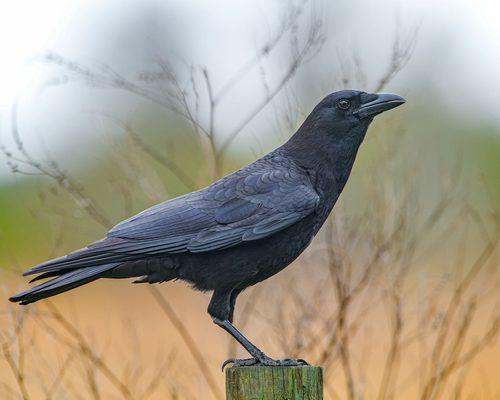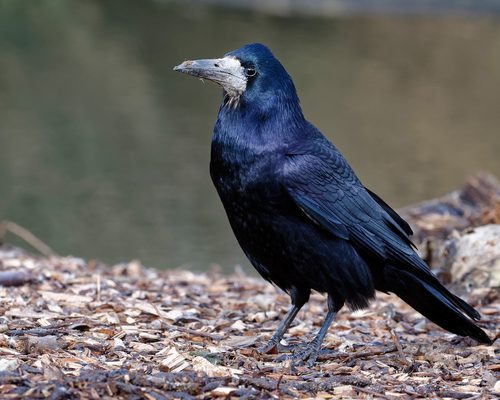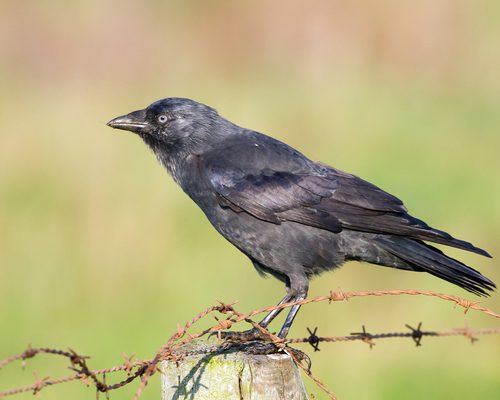Common Raven
Least ConcernCorvus corax
Visual Identification
Appearance
The Common Raven is a large, all-black bird with a thick neck, shaggy throat feathers, and a heavy, curved bill. Its long, wedge-shaped tail and broad, fingered wing tips are distinctive in flight.
Both sexes look alike, with adults displaying a glossy sheen to their plumage. Juveniles are similar but lack a glossy appearance and have duller plumage with brownish tinges.
Size
Length
54cm to 67cm
Wingspan
115cm to 150cm
Weight
689g to 1.625kg
Colours
Males and females have similar plumage
Primary Colour
Black
Secondary Colour
Brown
Beak Colour
Black
Leg Colour
Black
Habitat and Distribution
Habitats
Woodland
Garden
Wetland
Coastal
Urban
Farmland
Grassland
Desert
Tundra
Rainforest
Mountain
Savanna
Distribution
Common Ravens inhabit many habitats across the Northern Hemisphere, including forests, mountains, coastal areas, and tundra. They are highly adaptable and can also thrive in urban environments.
In North America, they are found throughout Canada, Alaska, and the western United States. In Europe, they occur across Scandinavia, the UK, and mountainous regions. Their range extends into parts of North Africa and Central Asia.
Elevation Range
Sea level to 5,000 meters
Climate zones
Temperate, Subarctic, Arctic
Distribution Map
This map gives you a rough idea of where you might spot a Common Raven. The coloured areas show countries where these birds have been seen.
A few things to keep in mind:
- Birds might not be everywhere in the coloured areas, for example, they may be present around the coast of that country
- Where birds live can change with seasons and available food
- This map is quite simple - it doesn't show exact locations
We're working on making our maps even better! Soon, we hope to show you:
- More detailed maps for bigger countries, including state and region
- How birds move around during different seasons
Distribution by Region
Behaviour and Ecology
Bird Attributes
This feature is in beta. We'd love your feedback to improve it!
Share your thoughtsBird Attributes Explained
Our bird attributes system rates various aspects of a bird's capabilities on a scale of 0-100, based on data from field observations, scientific studies, and expert knowledge.
Attribute Categories:
- Agility: Manoeuvrability, speed, and grace in flight or movement.
- Strength: Physical power, often correlating with size and hunting abilities.
- Adaptability: Ability to thrive in various environments or changing conditions.
- Aggressiveness: Territorial behaviour and assertiveness, particularly during breeding seasons.
- Endurance: Stamina, often seen in migration patterns or foraging behaviours.
Understanding the Ratings:
- 0-20: Very Low
- 21-40: Low
- 41-60: Average
- 61-80: High
- 81-100: Very High
Remember, these attributes are relative to other bird species and don't necessarily indicate superiority.
Hover over the icon next to each attribute for more information.
Tap the icon next to each attribute for more information.
Agility
Reflects the bird's manoeuvrability, speed, and grace in flight or movement.
The Common Raven displays remarkable agility, performing aerial acrobatics including rolls and somersaults in flight. Their ability to navigate diverse habitats from sea level to 6,000 metres elevation further demonstrates their impressive manoeuvrability.
Strength
Indicates the bird's physical power, often correlating with size and hunting abilities.
As a large corvid with a robust build, the Common Raven possesses considerable strength for its size. Their ability to crack open nuts and shellfish by dropping them from heights indicates significant physical power, though not at the level of larger birds of prey.
Adaptability
Represents the bird's ability to thrive in various environments or changing conditions.
Common Ravens exhibit exceptional adaptability, thriving in a wide range of habitats from forests and tundra to urban environments. Their problem-solving skills, tool use, and diverse diet showcase their remarkable capacity to adjust to various conditions and challenges.
Aggressiveness
Measures the bird's territorial behaviour and assertiveness, particularly during breeding seasons.
While not typically aggressive towards humans, Common Ravens can display territorial behaviour and engage in cooperative hunting. Their intelligence and opportunistic nature may lead to assertive behaviours, particularly when defending nests or competing for food resources.
Endurance
Reflects the bird's stamina, often seen in migration patterns or foraging behaviours.
The Common Raven's ability to inhabit diverse environments, including harsh climates like the Arctic, suggests high endurance. Their large size and capacity for long flights, coupled with their year-round residency in many areas, indicate substantial stamina and resilience.
Diet
Common Ravens are opportunistic omnivores with a diverse diet. They feed on carrion, small animals, insects, grains, fruits, and human food scraps. Their intelligence allows them to access various food sources, including cracking open nuts and shellfish by dropping them from heights.
Behaviour
Common Ravens are highly intelligent and social birds. They often engage in aerial acrobatics, performing rolls and somersaults in flight.
Ravens are known for their problem-solving abilities, using tools and exhibiting complex social behaviors, including cooperative hunting and food sharing.
Vocalisation
Nesting & Breeding
Common Ravens form long-term pair bonds and breed once a year, typically in late winter or early spring. Courtship involves aerial displays and mutual preening.
Nests are large structures of sticks, often placed on cliff ledges or in tall trees. Females lay 3-7 eggs, which are greenish with brown markings. Both parents contribute to nest building.
Incubation lasts about 20-25 days, primarily by the female. Nestlings fledge after 5-6 weeks but may remain with their parents for several months afterwards.
Lifespan
years
The Common Raven typically lives for 10 to 15 years.
Like all birds, lifespan can be affected by factors including predation, habitat quality, disease, and access to food sources.
Conservation and Status
Global Conservation Status
Birdwatching Tips
- Look for their large size and wedge-shaped tail in flight
- Listen for their distinctive deep, croaking call
- Observe their acrobatic flight patterns and playful behavior
- In North America, check high elevations and remote areas
- In the UK, visit coastal cliffs and upland areas
Additional Information
Quick Facts
Other names:
Northern Raven
Family:
CorvidaePredators
Did You Know?
- Ravens can mimic human speech and have been known to say words like 'hello' and 'goodbye'.
- They have demonstrated the ability to plan for the future, a trait previously thought unique to humans and great apes.
- In captivity, ravens have shown problem-solving skills on par with chimpanzees.
Was this bird profile helpful?
Your feedback helps us improve our content
Thanks for your feedback!
Your input helps us improve our content.
Community Experience
Community Ratings
1 rating from birders
Latest Community Reviews
Floof Claw
Community Reviews
Create Your Free Account Welcome Back!
Join our community to rate birds and share your experiences. Creating an account is completely free and only takes a minute. Sign in to your account to rate birds and share your experiences with our community.
Your information is secure and will never be shared.
By creating an account, you agree to our Privacy Policy.
Similar Birds
References
- 1
website: BirdLife International. 2017. Corvus corax (amended version of 2016 assessment). The IUCN Red List of Threatened Species 2017: e.T22706068A113271893.
View source - 3
website: BirdLife International (2024) Species factsheet: Common Raven Corvus corax.
View source - 2
report, 2004: Rich et al.



